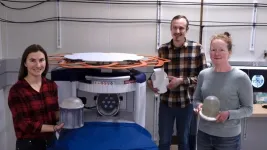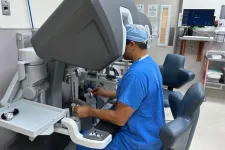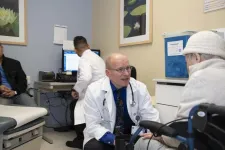(Press-News.org) CAMBRIDGE, MA -- When patients undergo general anesthesia, their brain activity often slows down as they sink into unconsciousness. Higher doses of anesthetic drugs can induce an even deeper state of unconsciousness known as burst suppression, which is associated with cognitive impairments after the patient wakes up.
A new study from MIT, in which the researchers analyzed the EEG patterns of patients under anesthesia, has revealed brain wave signatures that could help anesthesiologists determine when patients are transitioning into that deeper state of unconsciousness. This could enable them to prevent patients from falling into that state, reducing the risk of postoperative brain dysfunction.
One of these distinctive patterns emerged in the brain’s alpha waves (which have a frequency of eight to 14 cycles per second). Once patients became unconscious, these waves started to wax and wane in amplitude. As patients went deeper into unconsciousness, the pattern of this waxing and waning in amplitude, or amplitude modulation, continually changed.
“If you track this modulation as it gets deeper or shallower, you have a very principled way to track level of unconsciousness under anesthesia,” says Emery Brown, the Edward Hood Taplin Professor of Medical Engineering and Computational Neuroscience and a member of MIT’s Picower Institute for Learning and Memory and the Institute for Medical Engineering and Science.
Brown is the senior author of the new study, which appears this week in the Proceedings of the National Academy of Sciences. The lead authors of the paper are Picower Institute research scientist Elie Adam, Ohyoon Kwon ’20, and graduate student Karla Montejo.
Measuring brain waves
Brain waves, which are generated by synchronized neuronal activity, oscillate at different frequencies depending on what kind of task the brain is performing. When the brain is strongly engaged in mental activity, it produces higher-frequency beta (15-30 hertz) and gamma (greater than 30 hertz) oscillations, which are believed to help organize information and enhance communication between different brain regions.
Commonly used anesthesia drugs such as propofol have a significant effect on these oscillations. During anesthesia induced by propofol or other anesthetics that increase the effectiveness of GABAergic inhibitory receptors in the brain, the brain enters a state of unconsciousness known as slow-delta-alpha (SDA). This state is characterized by slow (0.1-1 hertz), delta (1-4 hertz) and alpha (8-14 hertz) oscillations.
With higher doses of these anesthetic drugs, the brain can fall into an even deeper state of unconsciousness. When in this state, known as burst suppression, EEG recordings from the brain show long periods of inactivity, punctuated by brief bursts of low-amplitude oscillations. When patients enter this state, they are more likely to experience postoperative confusion, delirium, and memory loss. These effects, which can last for hours, days, weeks, or months, are more common in elderly patients.
SDA and burst suppression produce distinctive EEG patterns that have been well-studied. However, they have been studied as separate brain states; what happens during the transition between the two states is less clear. That transition is what the MIT team set out to analyze in this study.
To do that, the researchers studied 10 healthy volunteers and 30 patients who were undergoing surgery. Most of the patients received propofol intravenously, and the rest received sevoflurane, a commonly used anesthetic gas. Both of these drugs act on GABA receptors in the brain, which reduce neuron excitability.
As the dosage of propofol was increased, patients showed two distinctive patterns of change in their EEGs. The first pattern was seen in the alpha waves, which started to wax and wane. As the dose increased, waxing was shortened and waning was prolonged, until the patient reached the state of burst suppression.
“You can see a very strong modulation, which is always there. As the modulation gets to be more profound, it eventually flattens out, and that's when the brain reaches the deeper state,” Brown says.
When the amount of drug was reduced, the amplitude of the alpha waves began to increase again.
The researchers also found a distinctive pattern in the slow and delta waves seen in the patients’ EEG readings. Slow and delta oscillations are the slowest brain waves, and as the amount of drug was increased, the frequency of these waves became slower and slower, reflecting a decrease in brain activity.
Metabolic disruption
The researchers hypothesize that propofol exerts these effects through its influence on neuron metabolism. The drug is postulated to disrupt the production of ATP, the molecules that cells use to store energy. As ATP production declines, neurons eventually become unable to fire, leading to burst suppression.
“This is consistent with the observation that burst suppression is very frequent in older patients, because their metabolic state may be less well-regulated than that of younger patients,” Brown says.
The findings could offer anesthesiologists more refined control over a patient’s state of unconsciousness during surgery, says Brown. He now hopes to develop an algorithm that could generate a warning that a patient is approaching burst suppression, which could be displayed on a monitor in the operating room. He says that anesthesiologists could also learn to make that determination by looking for these patterns in a patient’s EEG.
“One of the reasons we're excited about this is that it’s something you can actually see in the raw EEG,” Brown says. “Now that we have pointed out these patterns, they’re very easy to see.”
The researchers now plan to further explore what is happening to the brain’s metabolism during the transition to burst suppression, using animal models.
###
The research was funded in part by the Picower Institute Innovation Fund and the National Institutes of Health.
END
Study finds tracking brain waves could reduce post-op complications
Distinctive EEG patterns indicate when a patient’s state of unconsciousness under general anesthesia is more profound than necessary
2023-07-17
ELSE PRESS RELEASES FROM THIS DATE:
New NIST measurements aim to advance and validate portable MRI technology
2023-07-17
Magnetic resonance imaging (MRI) machines can clearly view non-bony parts of the body — soft tissue such as the brain, muscles and ligaments — as well as detect tumors, making it possible to diagnose many diseases and other conditions. However, the powerful magnets in conventional MRI machines make them expensive and bulky, confining them mainly to hospitals and other large facilities.
As an alternative solution, companies are developing new portable versions that have lower-strength magnetic fields. These new models can potentially expand the ways in which MRI is used. For instance, low-field MRI systems could be deployed in ambulances ...
A key function for tight junctions in embryo models
2023-07-17
SAN FRANCISCO, CA—As a human embryo grows, a set of molecules directs cells as they multiply and take on specific identities and spatial positions within the embryo. In one crucial step known as gastrulation, these signaling molecules guide a single layer of embryonic stem cells to form three layers of distinct cell types that will later become different parts of the body.
Now, researchers in the iPS Cell Research Center at Gladstone Institutes have shown that tight junctions between cells may play a critical role in gastrulation in human embryos.
“This study has ...
COVID-19 case studies offer insights into what it will take to combat misleading medical information online
2023-07-17
1. COVID-19 case studies offer insights into what it will take to combat misleading medical information online
Health care leaders ‘take a shot’ at addressing viral medical rumors and disinformation
Abstract: https://www.acpjournals.org/doi/10.7326/M23-1218
URL goes live when the embargo lifts
A team of medical and public health leaders from the American Board of Internal Medicine, ABIM Foundation, and several respected institutions say COVID-19 case studies, among other ...
Rice engineers’ storage technology keeps nanosurfaces clean
2023-07-17
HOUSTON – (July 17, 2023) – Rice University engineers have created containers that can keep volatile organic compounds (VOCs) from accumulating on the surfaces of stored nanomaterials.
The portable and inexpensive storage technology addresses a ubiquitous problem in nanomanufacturing and materials science laboratories and is described in a paper published this week in the American Chemical Society journal Nano Letters.
“VOCs are in the air that surrounds us every day,” said study corresponding author Daniel Preston, an assistant professor in Rice’s Department of Mechanical Engineering. “They ...
Researchers discover group of genes that influence pain and brain communication can also influence alcohol use disorder risk
2023-07-17
INDIANAPOLIS—An estimated 16 million people in the United States have alcohol use disorders (AUDs), according to the National Institutes on Alcohol Abuse and Alcoholism (NIAAA). Now, Indiana University researchers have made a substantial discovery in the role genes play in the development of AUDs, finding that alteration of a group of genes known to influence neuronal plasticity and pain perceptions, rather than single gene defect, is linked to AUDs.
“We know inherited genes are a major contributor to this disease, because ...
MSK Research Highlights July 17, 2023
2023-07-17
New research from Memorial Sloan Kettering Cancer Center (MSK) and the Sloan Kettering Institute — a hub for basic science and translational research within MSK — identified a way to reduce toxicity in CAR T cell therapy; discovered a division of labor in DNA repair that suggests a possible therapeutic strategy for certain cancers; developed a new method to enable imaging of two PET tracers simultaneously; found biomarkers that could help predict outcomes in HER2-positive metastatic esophagogastric cancer; and made progress toward improving options ...
First robotic liver transplant in U.S. performed by Washington University surgeons
2023-07-17
A surgical team from Washington University School of Medicine in St. Louis recently performed the first robotic liver transplant in the U.S. The successful transplant, accomplished in May at Barnes-Jewish Hospital, extends to liver transplants the advantages of minimally invasive robotic surgery: a smaller incision resulting in less pain and faster recoveries, plus the precision needed to perform one of the most challenging abdominal procedures.
The patient, a man in his 60s who needed a transplant because of liver cancer and cirrhosis ...
Rice study: Men vastly outnumber women in studying legislative politics
2023-07-17
It’s no secret that men outnumber women in the halls of Congress and in other political arenas, but new research from Rice University, the University of Wisconsin-Madison and the University of Illinois Urbana-Champaign also found that significantly more men than women study the legislative process in the U.S. and abroad.
This has troubling implications for the inner workings of the discipline and the overall study of topics that impact women’s political involvement, according to Leslie Schwindt-Bayer, the Thomas Cooke and Mary Elizabeth Edwards Chair in Government and Democracy ...
City of Hope-led panel of experts updates cancer and aging guidelines issued by the American Society of Clinical Oncology
2023-07-17
LOS ANGELES — In an effort to improve treatment outcomes and quality of life for older adults with cancer, researchers from City of Hope, one of the largest cancer research and treatment organizations in the United States, and colleagues across the country today released updated guidelines by the American Society of Clinical Oncology (ASCO) outlining the need to assess and manage vulnerabilities in patients aged 65 and older prior to prescribing chemotherapy, targeted therapy and/or immunotherapy.
The updated recommendations, published in the Journal of Clinical Oncology, urges the clinical use of a validated geriatric assessment (GA) — defined as an evaluation ...
Survival of children with acute lymphatic leukemia further increased
2023-07-17
The five-year survival of all children with acute lymphatic leukemia (ALL) has continued to increase to 94%. This is evident from a study of 800 Dutch children. Within the study, modified treatment protocols for four subgroups were examined. The modifications were found to have positive effects on survival and quality of life. For example, the risk of disease recurrence became as much as three times smaller for children with an aggressive form of leukemia. Says Prof. Dr. Rob Pieters: ‘The five-year ...
LAST 30 PRESS RELEASES:
Treasure trove of data on aging publicly accessible
Trees4Adapt project to address risks from climate change and biodiversity loss through tree-based solutions
Nature Communications study from the Lundquist Institute identifies molecular mechanism underlying peripartum cardiomyopathy
Pennington Biomedical’s Dr. Gang Hu appointed to NIH Reproductive, Perinatal and Pediatric Health Review Group
World-first project shows great promise to treat low eye pressure
New technique puts rendered fabric in the best light
Brain cancer digital twin predicts treatment outcomes
Cat disease challenges what scientists thought about coronaviruses
Paulson Family Foundation makes an additional $19 million donation to Hebrew University to fund a new building for electrical engineering. Together with its previous gift brings the total donation to
Canada–Estonia partnership advances community-centered clean energy
Sandia’s economic impact sets record for 17th consecutive year
Researchers uncover how tumors become resistant to promising p53-targeted therapy
Aligning games and sets in determining tennis matches
UOC research team develops method to evaluate apps for treating depression
Extreme heat waves disrupt honey bee thermoregulation and threaten colony survival
New brain study explains how binge drinking contributes to long-lasting negative feelings
The Food and Drug Administration’s regulation of mifepristone
Prescribing patterns of potentially inappropriate central nervous system-active medications in older adults
One in four older Americans with dementia prescribed risky brain-altering drugs despite safety warnings
Social media use and well-being across adolescent development
Child poverty trends by race and ethnicity in the U.S. from 2022 to 2025
Tissue repair slows in old age. These proteins speed it back up
Korea University Institute for Environmental Health completed an invited training to strengthen environmental health capacity for Karakalpakstan Medical Institute
Study offers evidence that racial bias is at play in overrepresentation of Black youth in Canadian child welfare systems
JMIR Publications’ JMIR Neurotechnology invites submissions on novel technological advances for neurological disorders
JACC issues inaugural report on state of US cardiovascular health
SwRI evaluates fire risks associated with solar panel installations
Discovery on how aggressive breast cancer controls protein production
A simple blood test can predict Crohn’s disease years before symptoms appear
FAU study reveals social, family and health factors behind teen bullying
[Press-News.org] Study finds tracking brain waves could reduce post-op complicationsDistinctive EEG patterns indicate when a patient’s state of unconsciousness under general anesthesia is more profound than necessary




